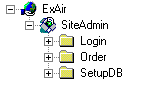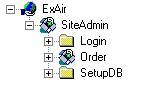An application is any file that is executed within a defined set of directories in your Web site. When you create an application, you use Internet Service Manager to designate the application's starting-point directory in your Web site. Every file and directory under the starting-point directory in your Web site is considered part of the application until another starting-point directory is found. You thus use directory boundaries to define the scope of an application.
You can isolate an application so that it runs in a separate memory space from the Web server. Isolating an application ensures that other applications, and the Web server itself, keep running even if the isolated application stops responding or fails.
In Internet Service Manager, an application starting point is indicated by a package icon. The following example shows an application with a starting-point directory named /SiteAdmin:

The files in the \Login, \Order, and \SetupDB directories are considered part of the /SiteAdmin application. A physical or virtual directory under an application starting point can be the start of a new application. In the following example, the files in the \Login and \SetupDB are part of the /SiteAdmin application. The files in \Order directory are not; they are part of a new application:

You can have more than one application per Web site. The default Web site that is created when you install Internet Information Server is an application starting point.
Internet Information Server supports ASP, ISAPI, CGI, IDC, and SSI applications. An application can share information among the files in the application; for example, ASP applications share context flow, session state, and variable settings across the pages of the application.